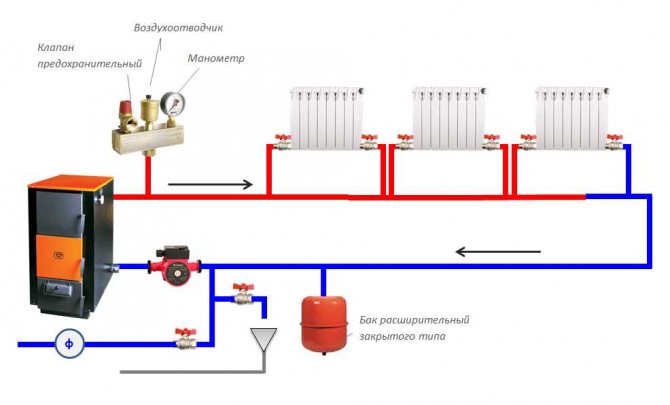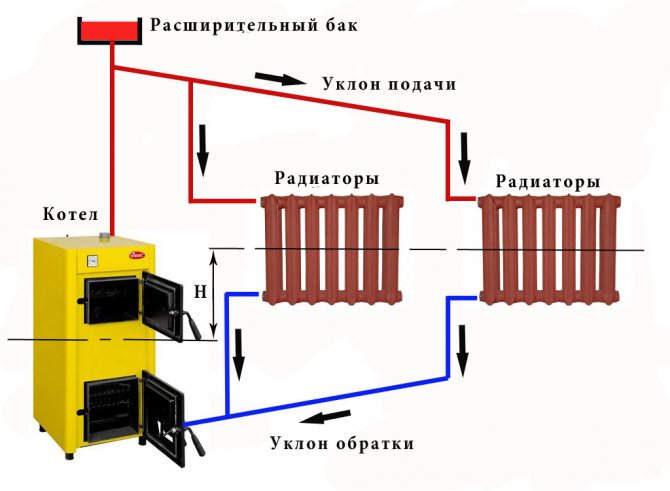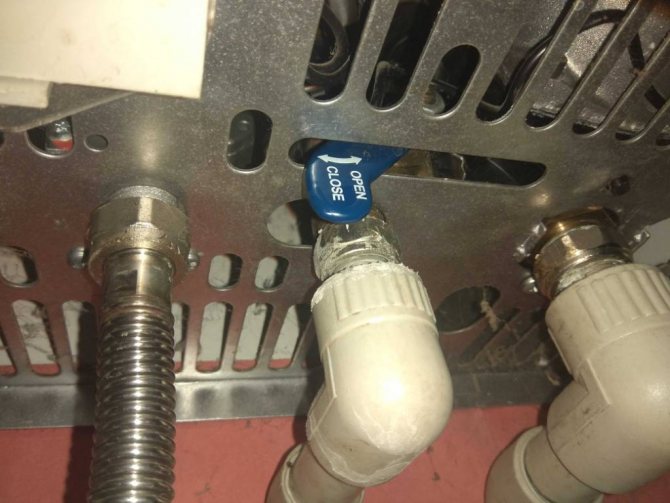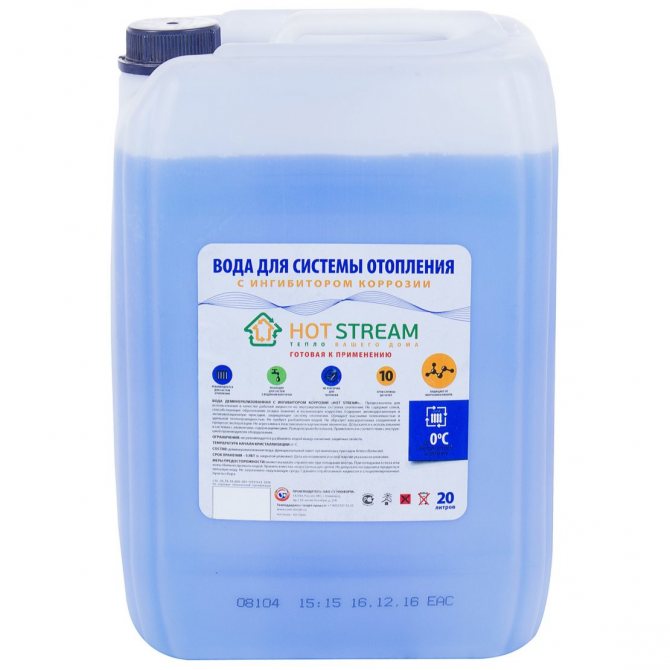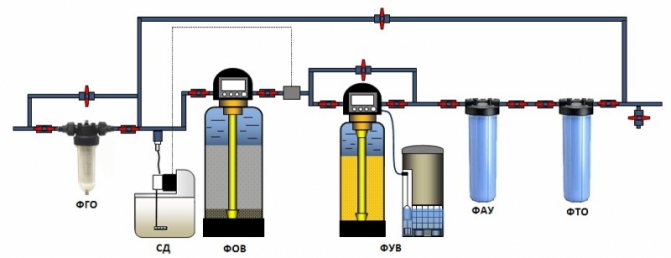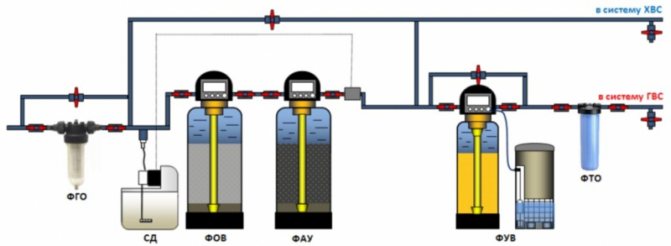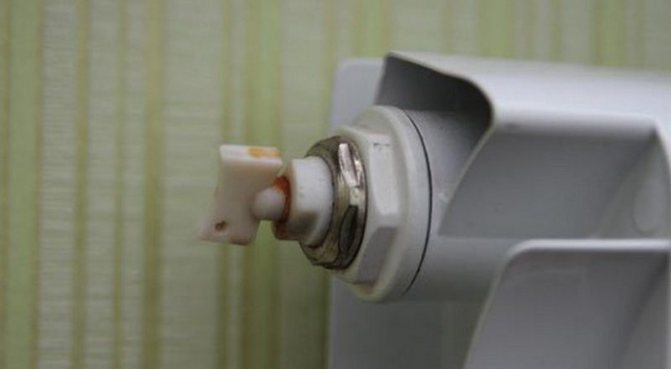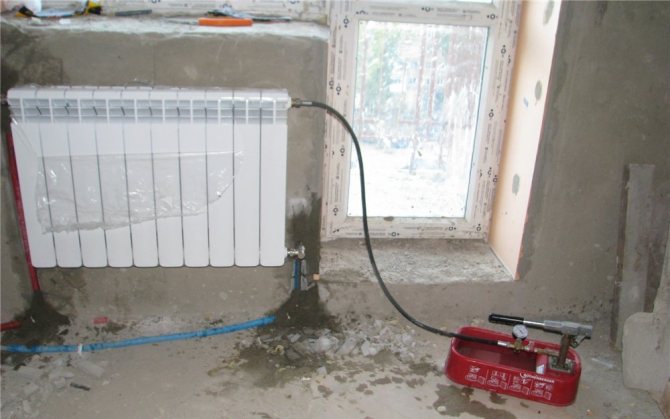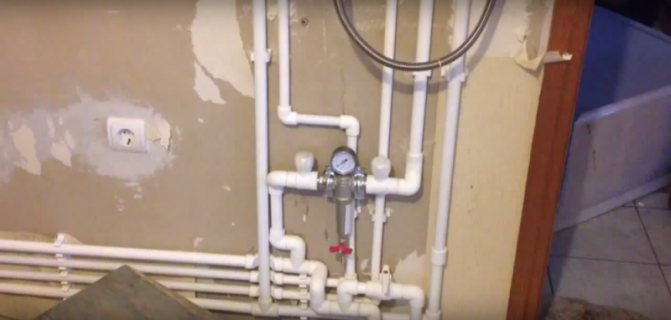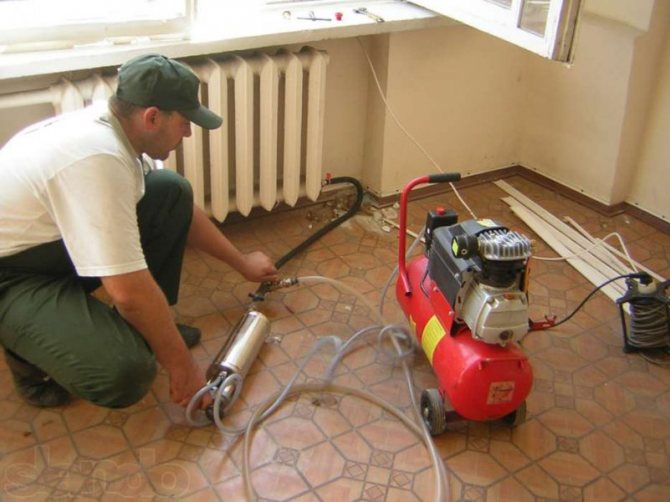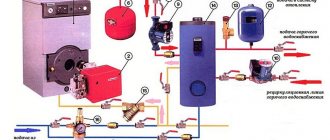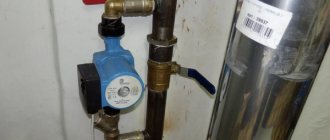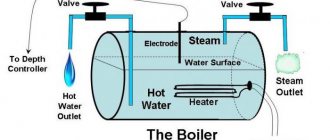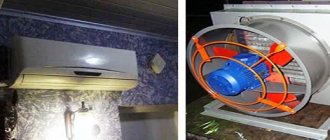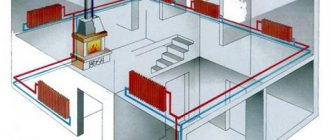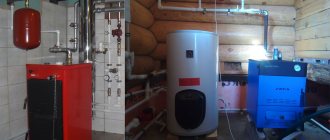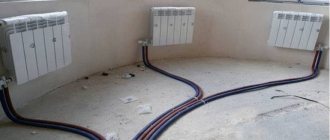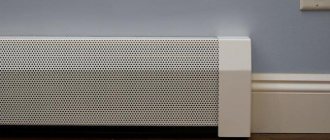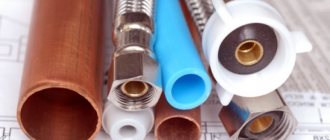When designing and building a private house, it is necessary to correctly select and install a heating system in the future. In apartment buildings, tenants do not have problems with this issue. Since the heating system in the apartment is centralized, and all the manipulations are performed by the appropriate services.
But private sector developers have to decide for themselves which heating system to choose. And you should find out how to properly set up the heating system of a private house or cottage. As a rule, many criteria are taken into account and the most optimal heating system is selected.
What is a heating system
A heating system is a whole complex of various equipment that is designed to generate and transfer heat to the end consumer, that is, the tenant of the house. The heating system includes a heat source, pipes through which this heat will be transferred, and heating radiators.
The heat source, as a rule, is either gas, or electricity, or diesel or other fuel. The coolant that is transferred through the pipes is usually water or antifreeze antifreeze liquid. Storage tanks for heating systems act as a heat energy storage device, they are built into the system circuit. Such a storage tank for heating allows you to store heat for subsequent supply.
Mixers are also used in modern automated heating systems. They mix hot water and chilled water from the return line in the heating system. The choice of the type of heating system must begin with the fact that it is necessary to decide what will act as a source of heat. In other words, you need to know if the water will be heated using electricity, gas or ordinary firewood. The next step is to select the appropriate boiler. Then the type of pipes is selected, or the option without pipes is selected, that is, the water flows directly into the radiator.
Boilers are still one of the most popular types of heating systems today.
On the territory of our country, the heating season, as a rule, lasts about two hundred days a year. When choosing a heating system, do not forget about this. The heating system is cleaned at the end of the season, and before the heating season it is rinsed and cleaned again.
Heating systems today are regulated very differently than their predecessors. Heating systems now are systems that maintain the required thermal characteristics in real time. Therefore, in such systems, a fundamentally new hydraulics of the heating system is used, in which there is a constantly changing mode. To maintain the appropriate temperature in the heating system, a thermometer is used for heating systems, which is built in separately.
After the heating system is installed, the pipes are checked and then water is poured into the system. Or, in another way, the heating system is fed with water in order to check the new system. Thus, the adjustment of the heating system is carried out, which is started for the first time. The heating system must be flushed for three hours. And the water after rinsing must be clean.
This procedure is necessary to remove construction debris that could appear there during the installation of the system. Then the second batch of water is heated to boiling. Boiling water also helps to get rid of oily debris.Any heating system must be flushed twice a year. Some owners of private houses are interested in how to pump water into the heating system to flush it. But first, you need to consider how to prepare the water for flushing.
Preparation of water for the heating system - all the nuances of the process
When winter gets closer, water is poured into the heating system. The preparation of water for the heating system is at the same time one of the key issues. The long-term operation of heating and quality depends on this.
If this issue is not taken into account, the equipment can quickly fail, this also applies to the heating system.
How to properly prepare the water?
When operating the heating system, water of the appropriate quality is used. In doing so, a number of important requirements should be taken into account. Otherwise, the system becomes clogged, its service life is reduced, and less heat is supplied to the consumer.
The boiler should be supplied with already purified water. If the work is carried out with poor quality water, with an increased level of hardness, the heating system can quickly fail. If the water is supplied from a central water supply system, it must be further softened.
To prepare water for the heating system, you should use the following rules:
- mechanical cleaning in order to eliminate solid impurities of various origins;
- sorption (thawing);
- removal of bacteria;
- water treatment.
If the area in which work is carried out during the winter is cold, antifreeze is added to the system.
In hot countries, substances are used that prevent the formation of sludge. Water softeners are selected at the request of the customer. Such devices make the water softer.
Chemicals can also be used for water purification. But at the same time, you should be prepared for the fact that other growths may appear on the equipment.
Oxidizing agents are used to remove solid deposits. When exposed to iron layers, they become heavy, and after such a reaction, they can be easily removed. Deaeration is used to remove dissolved gases from the water.
Boiler problems
The preparation of water for the heating system of a private house is an important stage in the operation of the system. Otherwise, the water may pose a threat to the water heater. The risk is associated with the presence of impurities of a different nature in it, and this is precisely the root cause.
To solve the problem, you need to understand the nuances of its occurrence.
The following types of impurities can be found in water:
- mechanical;
- dissolved, forming a precipitate;
- corrosive impurities.
Each of the above problems can cause boiler breakdown. In addition, they contribute to the stability and efficiency of the system as a whole.
Failure to pass mechanical filtration can lead to more serious damage. For this reason, pumps that circulate water fail, and the cross-section of the pipeline is reduced.
If the system uses purified water, the consumer does not face problems that entail a lot of unpleasant consequences.
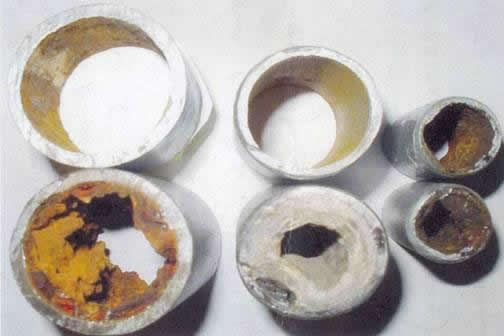
Pipes affected by limescale
Dissolved impurities cause more serious problems, which is associated with scale deposits, the appearance of corrosion, and salts. Such impurities require special attention, since if they are present in the water, the equipment completely stops functioning after a while.
The hardness of the water is increased by carbonate deposits. It can even appear in equipment where low-temperature exchange takes place.
Scale deposits significantly impair the supply of heat, and the loss increases. At the same time, heat carriers consume more electricity, and operating costs appear.
Scale usually forms when using poor quality water.At the same time, many problems arise in the form of corrosion, accumulation of oxidized metals and scale.
What is water like?
Water supply and well - these are the options that are most often used for the heating system. It also needs to be properly prepared. Self-made water for the heating system must be purified.
Each type of water has certain disadvantages, which entail certain problems when using.
Magnesium and calcium salts are some of the typical ones. This is what determines the rigidity. At each scheduled inspection, it is recommended to do laboratory tests of the water supply system.
In this case, attention should be paid to the following characteristics:
- smell;
- color;
- rigidity;
- the presence of iron;
- the amount of oxygen;
- mineralization;
- high oxidizability.
At home, special kits are widely used to prepare water for heating. You can buy them at a pet store.
Advice: the services of a laboratory that has all the necessary certificates give more accurate indicators and values.
Features of water softening
One of the important stages in preparing the system for operation is the softening of water for heating. In this case, it should be taken into account what kind of water is used.
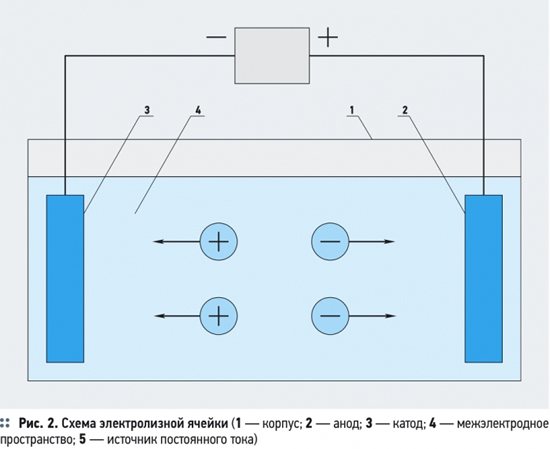

DC water purification circuit
Usually one set of filtration unit is used. Filtration takes place under the influence of direct current.
After such purification, water will be supplied extremely clean, softened, without excess salts. The energy consumption of such equipment is not significant.
Magnetic field treatment is another type of softening. The work is carried out using a power line. At the same time, salts precipitate; no lime layer remains on the walls of the equipment. This cleaning method is used only when the water in the boiler is heated to 100 degrees Celsius.
Indicators of softness after exposure to a magnetic field do not remain for long, but this is quite enough for the operation of the boiler. When using this or similar equipment, the water in the heating system softens. You can buy it in specialized stores.
Preparing the water for trouble-free operation of the heating system is an important step in the process. At the same time, the consumer receives water of a specified composition, which will not lead to the formation of build-ups in different parts of the system.
We hope this article was helpful to you. And you will prepare the water for your heating system yourself.
How to properly prepare the water?
So, in order for the heating system to serve for many years, it must be flushed at least twice a year. Since the system is flushed exclusively with water, there must be special requirements for water. What are the requirements for the water that the heating system is flushed with? And how is the preparation of water for the heating system carried out at this time? Next, we will consider the question of how to prepare water for the heating system on your own. Why are there strict requirements for water?
Using untreated water to flush the heating system can result in:
- to the destruction of pipes;
- to the formation of scale;
- to breakdown of heating radiators;
- to a decrease in the permeability of pipes, the amount of water in the heating radiator, thus decreases;
- to reduce the speed of the coolant;
- to excessive consumption of fuel and unplanned and unreasonable material costs.
As you can see from the above evidence, the speed of water in the heating system will decrease significantly, and the batteries will no longer warm us so much in winter.
What kind of water can be used for the heating system?
Contrary to popular belief, melt and distilled liquid are not entirely suitable for pouring as a heat carrier - the excess softness of the liquid is just as harmful as the hardness.Considering what water should be for the heating system, you should know that the content of salts, elements of heavy metals is more than the maximum limit, mechanical impurities and suspensions in the liquid are unacceptable.
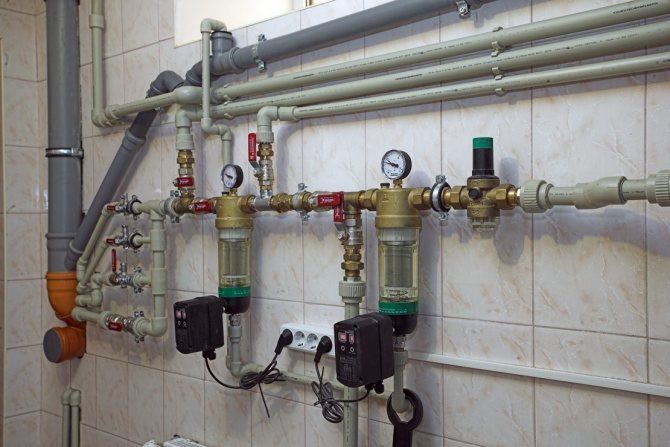

If you do not prepare the carrier, the structure will quickly fail due to the following reasons:
- destruction of the walls of the pipeline, boiler due to the reaction of chemically active components;
- the formation of corrosion, layers of scale on the inner walls of the elements.
The overgrowth of pipe tunnels leads to a decrease in the rate of circulation of the coolant, uneven heating of devices, an increase in fuel consumption and a decrease in heat transfer. Therefore, the coolant must be prepared before pouring into the system. Preparation plans include chemical analysis. This can be done with aquarium test kits or taken to a chemical laboratory. The second option is more reliable, gives a more detailed analysis and allows you to choose a system for better cleaning.
To take a sample, water is poured into a bottle or jar with a volume of at least 1.5 liters. It is not recommended to take bottles of sweet soda, tea and other drinks other than water. The jet is first drained for 10-15 minutes, then a water sample can be taken. The spill is needed so that the liquid stagnant in the pipes does not get into the bottle - such a sample threatens with erroneous results.
But to prevent oxygen from entering the bottle, the liquid is poured in a thin stream so that it flows down the wall of the container. Pour under the neck, close the lid tightly, take to a certified laboratory and wait for the results. If it is not possible to give a sample for analysis immediately, it is allowed to store water in the refrigerator for up to 2 days. The main thing is not to put the bottle in the freezer so that the chemical composition of the sample does not change.
Skirting heating, installation of water and electric radiators
How to soften water?
Therefore, it is so important to prepare the water for flushing the pipes. The first requirement for water, with the help of which the heating system is flushed, is its softness. Therefore, they try to soften the water. There is more than one water softener for heating systems on the market today. Further, the water is purified from various impurities, then defended and purified from harmful microbes and bacteria. This is an exemplary water treatment for a heating system for flushing the heating system.
If we consider the process of purification and preparation of water, then in brief this process will look like this. In order to soften water, various devices are used, for example, AquaShield. Such devices not only make the water softer, but also clean the inside of the equipment from scale. Previously, cationic resins were used to soften water. Also, water can be softened with various chemical reagents.
What kind of water can I fill?
The chemical composition of the water and its suitability for flushing the heating system can be determined using various tests. Such tests are done in specialized chemical laboratories. Having received the test results, there is no doubt about the reliability of the results and their high accuracy.
If taking water samples to a specialized laboratory is an overhead and troublesome business, then you can use various kits for water analysis at home. These express kits allow you to determine the hardness of water and its ph level. With the help of these tests, it is also possible to determine various impurities in water, this is iron, various sulfides, nitrites, nitrates, etc.
After determining the composition of the water at home or after receiving the analysis results from the laboratory, it is necessary to bring the water indicators back to normal. It is believed that about 0.05 mg / m3 of dissolved oxygen should be present in the water. The acidity level of the water should be in the range 8.0 - 9.5. The iron content in water should be no more than 0.5-1 mg / l.The indicator of water hardness should be in the range of 7-9 mg eq / l.
Such analyzes must be carried out twice a year.
Various microbes and microorganisms that are contained in the water, naturally, greatly impair its quality. Thanks to these pathogenic microbes, a mucous membrane can form on the pipe walls.
Why use a softener to reduce water hardness
A filter can be used as a water softener. What dangers can lie in wait for the owners of the heating system who do not use special filters to reduce the hardness of the coolant? First, calcium and magnesium salts, which are found in large quantities of hard water, are converted over time into limescale.
Secondly, these insoluble deposits attach to the pipe walls and reduce their permeability. This does not allow the use of water consumption control and metering devices. Pipes gradually fail. The worst thing about this situation is that the process of deposition of insoluble residues and the formation of scale is a long process. It is invisible to the users of the system. Therefore, water softening filters are required.
Chemical compounds in the heating system - as a water softener
Chemicals could be an alternative to using filters. But they have not become a worthy replacement. Polyphosphates are used from chemical compounds and reagents. Polyphosphates prevent scale particles from bonding to each other. But in this case, these chemical reagents must be constantly present in the heating system. And another disadvantage of chemical reagents is that they do not adjust to the new level of water hardness.
The second type of chemical reagents that are used to soften water hardness are reagents for prophylaxis or for purifying water after using it. You can use a heating concentrate that is compatible with antifreeze. It is used for corrosion protection. Now you can return to the question of how to pump water into the heating system yourself.
Too hard and too soft water
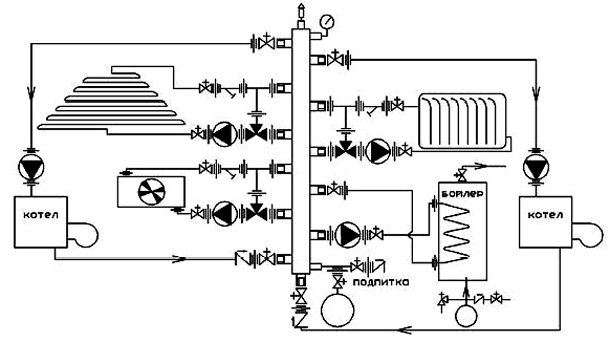

An example of a boiler room diagram for a heating system that provides quick installation and comfortable heating and preparation of hot water in a private house, cottage, dacha.
Normal hardness values are 7-10 mg-eq / l. If this value is exceeded, it means that the water contains an excessive amount of calcium and magnesium salts. When heated, the salts precipitate, known as scale. Accumulating inside pipes and radiators, scale prevents heat transfer and contributes to wear and tear of the heating system.
The most affordable way to soften water is boiling. Heat treatment removes carbon monoxide and therefore significantly reduces calcium hardness. However, some calcium remains in the water, so boiling will not completely remove the hardness.
Another cleaning method is the use of filters with scale inhibitors (neutralizers), such as lime, caustic soda, soda ash. Hard water is also passed through ion exchange resin filters, with the potassium and magnesium ions being replaced by sodium ions.
The use of magnetic softeners is a non-reagent water softener. Under the influence of a magnetic field, the properties of water change so that potassium and magnesium salts lose their ability to form in the form of a solid precipitate and are released in the form of loose sludge. However, salts still remain in the water and need to be removed. In addition, this method is not so effective at water temperatures above 70-75 degrees (that is, the temperature typical for boilers, water heaters and boilers).
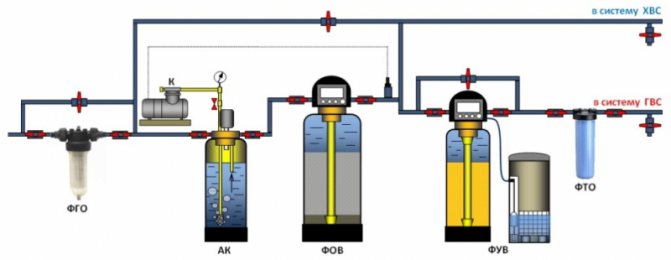

Coarse cleaning and deferrization of all water, water softening for heating systems and hot water supply (DHW).
Reverse osmosis purification consists in forcing water through a special membrane that traps harmful substances.This allows you to completely remove calcium and magnesium salts that cause limescale. But this method also has disadvantages: the high cost of treatment equipment and the consumption of a large amount of water during cleaning (for 1 liter of clean water, about 2 to 10 liters are drained into the sewer).
Too soft demineralized water, for example, rain or melt water, is no less harmful to the heating system than hard water, since the calcium salts contained in the water neutralize acid reactions, slowing down corrosion. Therefore, before using rain or melt water for the heating system, you should let it settle for several days and fill it only after making sure that its pH level is within 6.5-8, but not lower. This is especially important if the routing was made of non-galvanized pipes, which are prone to corrosion in the first place.
Related article: Laying (installation) of floor slabs
How to pour water into the heating system
There are two types of heating systems. It is a closed type heating system and an open type heating system. In an open system, water comes into contact with air. This happens through the tank, which is located at the highest point of the heating system. In a closed system, water does not come into contact with air.
To pour water into a closed-type heating system, you must:
- Have a pump for drawing water from a well or reservoir. Using a hose that is connected to the pump and to the drain pipe, pump water. All taps open at full capacity. It is important to prevent overheating in the heating system, so you need to constantly adjust the water supply.
- Particular attention should be paid to the pressure with which the pump delivers water, and to regulate the pressure required for the heating system. And this is 1.5 atm.
- To calculate the volume of the heating system, you need to know how many liters are in the radiator and one running meter of the pipe.

